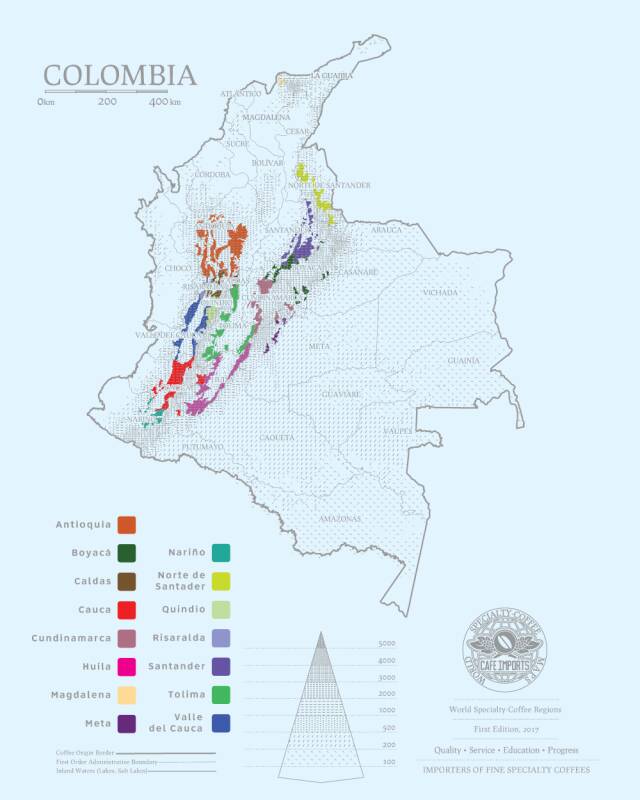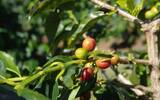Introduction of Rose Valley Coffee beans in Dashu Manor, Santander, Colombia
Colombia is a land, sea and preparation country located in northern South America, connected with Venezuela, Brazil, Ecuador, Peru, Panama and other countries, bordered by the Pacific Ocean to the west and the Caribbean Sea to the north. The topography of Colombia is roughly divided into western mountains and eastern plains, mainly the Andes in the west and Orinoco and Amazon plains in the east. The national average temperature in Colombia is 15.8 ℃-20.5 ℃, and the annual rainfall is 1000-2500 mm. High-altitude mountains, volcanic soil, abundant Rain Water and different microclimates are very suitable for growing coffee, making Colombia the third largest coffee producer in the world.
Colombian coffee development
It is recorded that coffee was introduced into Colombia in the late 18th century through Jesuit priests among the Spanish colonists. The first batch of coffee was planted in Santander and Boyaca provinces and then spread to other regions. However, during the period 1899-1903, war broke out in the Colombian country, resulting in a sharp decline in the population of coffee growers and a large number of plantations abandoned. When the war ended, in order to save the coffee industry, the government began to integrate the wasteland and divide it into small plots, selling it to farmers at very low prices, allowing them to grow coffee and other crops and start a new life. By 1912, coffee had developed and accounted for 50% of Colombia's total exports.

In 1920, at the proposal of a farmer, the Colombian Coffee Union was formed to protect the interests of small coffee farms. Since then, the organization has grown, and in 1927 led to the more authoritative and regulated Colombian National Coffee producers Association, or FNC. Since its establishment, FNC has taken a series of measures, including strict quality control, the establishment of the National Coffee Research Center, the creation of Juan Valdez Juan Valdez and his mule Conchita to promote Colombian Coffee, etc., to enhance the global competitiveness and influence of Colombian Coffee.
Santander of Santander production area
Colombia has a large land area, so Colombia has a number of coffee-growing areas, including Santander, Huilan, Cauca, Nalinglong and Lima. And due to the mountain terrain, different microclimate and other planting conditions, so the taste of coffee planted in each region has many differences.

The Santander producing area is located in northern Colombia, in the Andes, and is planted at an altitude of about 1400-1700 meters. Santander is a very important but rarely mentioned province, but it was actually the first province in Colombia to grow coffee. At present, Santander accounts for 5% of Colombia's coffee production, but most of the coffee varieties planted in this area are Kaddura, Castillo and so on, many of which are leaf rust-resistant varieties. This also makes Santander an endemic area of low leaf rust in Colombia and around the world. The coffee beans in this area are famous for their strong taste, long aftertaste and unique fresh vegetation flavor.
Big Tree Manor Finca El Arbol
Dashu Manor is located 1700 meters north of Santander Coffee producing area. Dashu Manor is one of the few plantations in Santander producing area to grow a single variety. Vargas, the owner of Dashu Manor, has been growing coffee in Dashu Manor for 20 years. After years of development and attempt, he has more understanding and practice in coffee planting and processing.
Kaddura Caturra
Kaddura, a natural variety of bourbon, was found on a plantation in the Brazilian state of Minas Gerais between 1915 and 1918. There is a mutation in a group of genes in bourbon planted in the plantation, causing the plant to grow smaller. This variety is suitable for planting in the high altitude area from 700m to 1700 m. It has strong adaptability to altitude and has a good flavor in the high altitude area, but the production capacity is relatively reduced.
Front Street Coffee Columbia Big Tree Manor Rose Valley Coffee Bean producing area: Santander Manor / processing Plant: big Tree Manor elevation: 1700 meters above sea level: Kaddura treatment: anaerobic enzyme washing flavor: peach cranberry wine heart chocolate roses
The Rose Valley coffee beans of Qianjie Coffee are from the Big Tree Manor in the Santander region of Colombia. This Rose Valley coffee bean is washed with anaerobic enzymes and roasted moderately. The front street will be boiled with a ratio of V60 to 1 ℃ and 92 ℃ water temperature. it will smell of rose and wine chocolate, with berry-like acidity, cranberry and peach flavor, sweet fruit and smooth taste.
Important Notice :
前街咖啡 FrontStreet Coffee has moved to new addredd:
FrontStreet Coffee Address: 315,Donghua East Road,GuangZhou
Tel:020 38364473
- Prev

Costa Rican production fell, coffee exports fell by nearly 30%
Recently, according to data released by Costa Rican coffee agency ICAFE, Costa Rica's coffee exports fell 28% in January compared with the same period last year, mainly due to reduced harvests and strong international supply. According to ICAFE, the total volume of goods in January was 60757 bags, each bag.
- Next

The shipping problem of coffee export is serious, and the number of coffee stocks in Europe is declining.
According to the Brazilian Coffee exporters Association (Cecafe), before January 25, Brazil exported a total of 2486267 bags of coffee, of which 2013917 bags of Arabica beans accounted for 81%, and 280995 bags of Robusta beans accounted for 11%.
Related
- What effect does Italian American coffee with filter paper have? Will coffee taste better if it is put on filter paper at the bottom of the powder bowl?
- What is the color difference in coffee beans? What are the characteristics of honey processed coffee beans? Why are the anaerobically treated coffee beans uneven in color?
- How does novice Xiaobai quickly get started and make coffee? Newbies learn to make coffee by hand and share the specific steps and process process!
- Costa tea has a shelf life of 100 years?! Expert: Unable to verify
- It's a huge uproar! American milk addition was rejected by Manner employees?!
- Mocha pot coffee bean recommendations| How fine and how much powder should be used for grinding? What parameter ratios do I need to use to make milk with Mocha pot coffee?
- What are the characteristics of the world's top ten coffee beans treated with Costa Rica honey? How to make black honey kadura from Tarazhu Pilon Processing Plant taste good?
- How to make deep-roasted coffee? What grinding water temperature does authentic Jamaica Blue Mountain No. 1 coffee use to brew it well?
- Selected high-grade rose summer coffee flavor tasting guide Why Panama rose summer has the aroma of flowers and fruits
- What equipment does a novice Xiaobai need to buy to learn to make coffee? Filter cup electronic scale bean grinder manual flushing pot purchase guide

